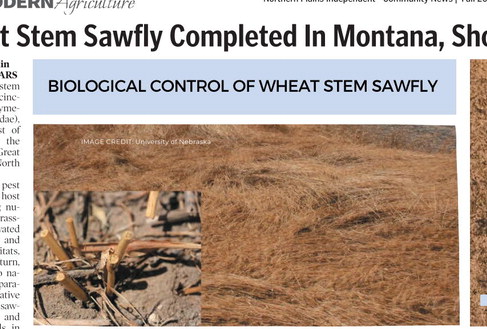Wheat Stem Sawfly Completed In Montana, Shows Different


The wheat stem sawfly, Cephus cinctus Norton (Hymenoptera: Cephidae), is a major pest of wheat across the northern Great Plains of North America.
The wheat pest has a wide host range, attacking numerous wild grasses and cultivated cereals in crop and grassland habitats, where it is, in turn, attacked by two native braconid parasitoids. Quantitative assessments of sawfly infestation and parasitism levels in different grass species across the full spectrum of available hosts are important in assessing the extent to which grasslands, or specific grass species, may be reservoirs of pests or parasitoids moving into wheat, particularly when determining beneficial seeding mixes for CRP or cover crops adjacent to susceptible wheat fields.
Agricultural Research Service scientists with the USDAARS Northern Plains Research Laboratory in Sidney (Drs. Tatyana Rand and John Gaskin) and the Systemic Entomology Laboratory in Beltsville, Md., (Dr. Robert Kula) are studying that issue and have recently quantified infestation and parasitism levels in over 25,000 stems collected from 17 grass species and wheat spanning 35 sites in central Montana over a two-year period.
The results of the study were published in the June 2024 issue of the Journal of Economic Entomology.
In that study, the authors found that infestation levels in five grass species, primarily wheatgrasses, were high (38 to 65 percent) and similar to the levels observed in wheat (55 percent), according to ARS Research Ecologist and lead author Tatyana Rand. In contrast, she said, the majority of grass species (12 of 17 in the study) had significantly lower levels of infestation (<10 percent), suggesting that most grasses are not important reservoirs of the sawfly.
Those species demonstrating low pest infestation levels included bluegramma (Bouteloua gracilis (Willd. ex Kunth) Lag. ex Griffiths) and three sampled Poa spp. providing quantitative support for the long-held observation that grammas and bluegrasses are generally less attacked. Native grasses determined to be less preferred included bluebunch wheatgrass, P. spicata, or greenneedlegrass, N. viridla, which could also provide alternatives for grassland plantings, Rand said
BIOLOGICAL CONTROL OF WHEAT STEM SAWFLY
IMAGE CREDIT: University of Nebraska
KERNZA/INTERMEDIATE WHEATGRASS, REFUGIA FOR
EXAMPLE OF LANDSCAPE CRP WHEAT
IMAGE CREDIT:





